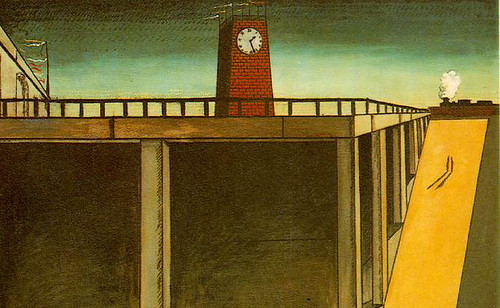
André Kertész, Meudon 1928
Several years ago I wrote an article for Modern Painters, chiefly about this photograph. Meudon is a Parisian suburb and Kertész, sensing there was a photograph to be taken there, returned to the area, and to this spot in particular, a few times before getting this one.
Just what is it about this photograph? A touch of this Chirico perhaps?

Or perhaps this by the same artist?

Or this Paul Nash?

Nash had seen Chirico as had Kertész. It is how ideas and images move around, like shadows, like half-remembered motifs. Frail structures left dangling in the imagination. I like the Kertész best. It sings whereas both the Chirico and the Nash retain an air of programmatic, somewhat prosaic deliberation. Though it's a nice Nash, imitated, or remembered in its turn, or so I seem to remember, by Alfred Hitchcock in a scene from Marnie, a street with a ship at the end of it. (Am I dreaming this? Have I written about this before in the blog, a long time ago?)
And why is the Kertész so good? Is it simply a nice, phallic surreal train that takes his or our fancy? Far too crass! Is it the man in the hat with the picture under his arm? Is it the height of the viaduct? Is it the figures walking away from us at the end of the street towards the building site? Is it just a disturbing formal balance, the centre of gravity faintly tipping away from the foreground figure as his hat lines up with the central column of the viaduct? If the picture were any darker it would be a little too stagy, a touch self-conscious.It is 'found' and yet seems permanent.
It is, I think, much to do with the power of the not quite fully articulated symbol. The dark figure removing a hidden object, the sharpness of focus, the silvery quality in everything. The plume of smoke disappearing behind the eaves of the roof. Oh and yes, the memories we have of pictures such as those by Chirico, those peculiar Chinese whispers of association that Chirico himself depends on.
We are easily haunted. The photograph still takes my breath away, as if some secret of the universe were being revealed in it, one I could locate if only I knew where to look. But I don't so there is only the haunting. And the clarity.

8 comments:
If you told that photo as a dream to Freud you'd be visiting his couch for weeks.
On the other hand if you told it to O Henry he'd knock off a 30 or 40 page story about it in next to no time.
Personally I think it's a door-to-door cork flooring salesman with a sample.
"We are easily haunted." Oh yes, there's the nub, why excellent photography works the way that it does, Cartier-Bresson's 'Decisive moment'. After all, just what is it that makes that moment so decisive?
Curiously, I had just watched something about Kertesz's 'Meudon' before going to bed last night.
And here it is, the first episode from BBC's 'Genius of Photography' (which opens with an examination of that particular image):
http://www.youtube.com/watch?v=QsZO0gUghxA&feature=related
Also a nice interview with Kettesz here:
http://www.youtube.com/watch?v=2XXdUYWocsc
I have just written a feature article for a photographer (a cousin of mine) which has been published in the Irish Arts Review. His website is here:
http://www.davidstephenson.ie/
The article is about a particular project he's working on, photographing two traveler families:
http://www.davidstephenson.ie/galleries/view/2
These landscapes without a single tree or plant almost seem to be interiors. And there's a surreal quality of the train above the people. And the street clothes of another time. Maybe this one is a time and space travelling machine. And I always love the sliver prints, because there is never more dynamic black and white.
The man and the train are momentarily attached to each other. Because they are going in opposite directions, they manage to stop time...
Similar opposite forces are captured in that famous photograph by Cartier-Bresson of a man leaping across a giant puddle. His leap is echoed by a ballerina on a poster in the background who is leaping in the opposite direction. Both of these leaps are echoed by their reflection in the giant puddle, moving the picture into an almost supernatural realm of compositional balance and ethereal depth.
Thank you for the comments. Thank you Mark particularly for the links. I have watched all the Kertész interviews and it was fascinating to see the contemporary footage of Meudon on the other film. Isn't the sense of space completely different!
Interesting about the interiors, Dana. That's what the Paul Nash painting is and it is very close in feel and spirit.
Jonathan, you are on to something there about counter-movement and stopping time. Would we get that with a photograph in an ordinary street with people walking in opposite directions? I suspect the composition would have to be dead right, whatever that means.
PiR, now I am getting really interested in cork flooring.
Incidentally, Mark. Your man David Stephenson look like a very fine photographer. I am chiefly impressed by his Meantime and Reportage series. Pass him my congratulations.
I think the photo's strength is that split-second capture of the world as stage set - surrealism peeping through the curtain to remind us that 'sur' might just as well be 'sub' on occasion. Like those David Lynch moments - in Twin Peaks, the recall of 'Bob' being right there in the periphery of the bedroom all the time.
Re Chirico - I've a bit on here;http://www.poetryireland.ie/publications/guest-blog/
regarding his influence on Marina Carr's new play at the Abbey.
"Isn't the sense of space completely different!"
Completely. All a photo needs is a few elements (sometimes just one) to make it come alive.
Glad you like Dave's work. I'll pass on your congrats.
Post a Comment